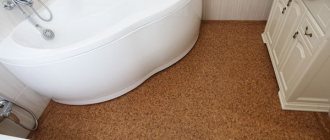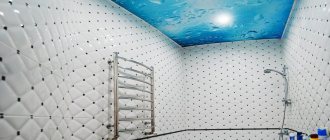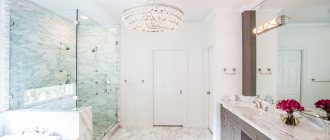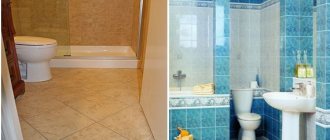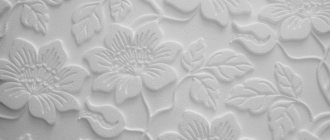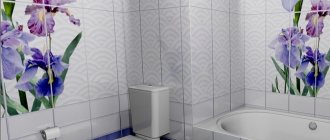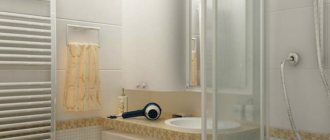The most visited place in the apartment is the bathroom. For this reason, interior decoration occupies one of the central places in the development of living space design. There are a huge variety of decor variations today, for example, the ceiling in the bathroom is made of plastic panels. Such finishing materials have their own unique characteristics and individual advantages.
The plastic ceiling is easy to install, looks attractive and retains its original appearance for a long time even in rooms with high humidity
Suspended ceilings have gained significant popularity today. Mirrored, matte, painted in various shades - these varieties allow you to decorate the bathroom and create a unique atmosphere of comfort and coziness.
Types of plastic finishing
The most famous varieties:
- “Lined”: named for its resemblance to the wooden prototype, the border between the lamellas is visible.
- Seamless: the parts are joined through a tongue-and-groove lock without a gap.
- Rack: The slats fit into the slots of the perforated steel stringers. In apartment buildings they are used without long adjustable rods.
- Sheet: the slabs are held in place by the binding, the scope of application is public buildings, high spacious rooms.
For bathrooms in apartment buildings, the first two types are typical, less often a simplified slatted version, concealing from 3 to 12 cm of space.
Lining
Often attached to a wooden frame, it organically complements identically decorated walls. The depressions between the “boards” collect water, causing unpleasant dripping, so ventilation is necessary.
A transverse set of lamellas visually reduces the room, a longitudinal set does the opposite.
- Dimensions of the regular version: 100*3000 mm, reinforced version 125 mm wide. Standard thickness is 8 – 10 mm.
Seamless PVC panels
The optimal choice for tiling. By choosing a shade and pattern, stylistic unity is achieved. Glossy plastic in light colors visually expands the boundaries.
The absence of seams facilitates cleaning and prevents mold.
- Length of seamless slats: 2600, 2700, 3000, 6000 mm. Width: 150 – 500 mm, typical – 250 mm.
- Thickness ranges from 5 to 10 mm, thin samples require extreme care.
Rack and pinion systems
Provides for compensation of deformations by means of suspensions; lack of height forces one to abandon the latter.
Advantages of the concept: installation of panels without hardware, breathable joints.
Repairs with plastic panels are carried out on your own, with just your own hands; there is no need to unscrew anything: the panels are snapped off from the support rails and replaced with new ones. The option makes it easier to inspect ventilation, lighting fixtures, and update the interior.
Stringers are compatible with aluminum slats.
Shape and size
To decorate the ceiling with plastic panels, rectangular lamellas are most often used. These elements have the following dimensions:
- length from 2.6 to 3 meters;
- width from 15 to 50 cm;
- thickness 8-12 mm.
Square-shaped ceiling panels in the form of tiles are less commonly used; their sizes can be different; the side length of one element varies from 30 cm to 98 meters. If it is necessary to make the ceiling completely seamless, then we install sheet panels.
They are sold in large sheets, so one sheet can be installed in the bathroom of a typical apartment. The thickness of such sheets can be from 3 to 6 mm; greater thicknesses of material are not used, since one mounting element (sheet) would be too heavy and difficult to work with.
Advantages and disadvantages
“There are no friends according to taste,” in addition to aesthetics, one has to take into account performance properties, cost, and technology. The advantageous combination of characteristics has made plastic in demand in the budget design of wet rooms.
pros
A ceiling in a bathroom made of plastic panels is a practical solution that completes the renovation of a room; proponents of plastic are attracted by:
- Moisture resistance: PVC does not rot, does not absorb water - the polymer is not afraid of condensation, splashes, parts retain their dimensions when air humidity changes.
- Chemical resistance: polyvinyl chloride does not react with household chemicals, fumes and droplets of which cause corrosion of aluminum finishes.
- Hygiene: the surface can be easily cleaned with a damp sponge; the dense structure prevents the fungus from settling.
- Manufacturability: minimal skills allow you to make an elegant plastic ceiling in a typical bathroom with your own hands. Light weight simplifies installation; a light frame is enough to attach the panels
- Decorative: they produce matte and glossy products in a rich color palette. The drawing can imitate the texture of wood, rocks, or represent artistic images.
- Cost-effective: financial costs per unit area are minimal among suspended ceiling systems.
Minuses
Opponents of PVC recall the disadvantages:
- Low strength: thin-walled elements are easy to damage during installation.
- Deformations: a consequence of warping of the wooden frame, insufficient rigidity of the fins of cheap models.
- Limited durability: over time, the surface layer degrades, becomes dull, and gets scratched, but high-quality samples retain their appearance for 10–15 years.
- Violation of ventilation: drops appear due to the blocking of vents with a false ceiling; modernization of ventilation eliminates the problem.
- Fire hazard: polyvinyl chloride is a self-extinguishing polymer, smoke contains toxins, but in case of a large fire there are no absolutely safe materials.
Leafy
They are distinguished by high aesthetic characteristics, because... In this case, the joint areas are completely absent. Sheet plastic ceiling panels for the bathroom perfectly resist moisture, which makes them possible to wash. Along with a huge palette of colors, the variety of textures is also striking. A line of “apron” panels has been developed especially for kitchens, which can replace traditional tiles. In the bathroom they often use the so-called. “mosaic”, giving the room a special elegance. At dachas, ceilings with imitation brick, marble, stone and wood are installed.
How to make a ceiling in a bathroom from plastic lining
Installing a ceiling made of plastic lining is in many ways similar to assembling a ceiling made of PVC panels. But since lining is considered a heavier material, a metal frame is installed instead of wood.
In this regard, the corresponding requirements for the set of tools: it must contain metal scissors for trimming metal profiles. PN 28/27 guides are used as a wall profile, and PP 60/27 ceiling profile is used for the base of the frame.
The frame strips are attached to the base ceiling using hangers - thin metal plates with perforations along the edges.
Correct cutting of metal profiles:
- measure the distance from wall to wall;
- measure this distance on the profile;
- make a mark with a pencil;
- Use metal scissors to cut the side flanges of the profile one by one;
- bend the profile at the incision site;
- cut along the formed fold line.
After cutting the planks, do the following:
- beat off the ceiling level;
- put marks in the places where the profile wall strips are attached (in increments of 50-60 cm);
- drill holes in the profile and walls;
- install dowels;
- attach the profile;
- The frame is assembled (longitudinal and transverse planks are installed).
Start installing the hangers:
- mark the fixation points of the suspensions on the ceiling (they should be located along the lines of the frame planks);
- drill holes in the ceiling;
- install dowels;
- hangers are attached.
Next, the frame is assembled from the ceiling profile PP 60/27 and a set of linings is carried out by analogy with a set of PVC panels.
How to make a bathroom ceiling from plastic slats
Installing a slatted ceiling is a quick and effective way to decorate a bathroom. Most manufacturers of this finishing material offer ready-made kits for standard-sized rooms. For example, 1.7x1.7 m and 1.35x0.9 m.
If the bathroom has different dimensions, you will need to inform the salesperson of the outlet, who will select the optimal configuration for the slatted ceiling.
But the first thing you need to do is decide on the appearance of the finish. The fact is that manufacturers offer two types of slatted ceilings: closed (slotless) and open (slotted) type.
Thanks to the “telling” names of these ceiling installation options, it is easy to understand that in the first case the canvas will be solid, in the second - with gaps between the panels.
One more nuance: you need to choose the design of the panels.
The most popular are French and German. They differ in the profile of the panels. In French it is round, in German it is strictly rectangular. Therefore, when choosing a French design and a closed installation method, small depressions will be noticeable on the ceiling. Due to the play of light and shadow, they will give it a special appeal.
If you need a strict and laconic design, you need to choose German.
The frame of the slatted ceiling is mounted not from wooden blocks and metal profiles, but using the following components:
- U-shaped profile (for wall guides);
- stringers (for longitudinal and transverse strips).
Installation of a slatted ceiling is carried out by alternately going through all the stages listed in the instructions for installing a plastic ceiling made of PVC panels.
The slats are assembled not in the same way as in the case of PVC panels and lining (by the tongue-and-groove method of fixation), but by snapping them into special recesses in the frame strips (stringers). The panels are joined along the length using an H-shaped profile.
A slatted ceiling, like any other plastic ceiling, will last at least 10 years. It is suitable for installing recessed lamps, is easy to clean, and has a glossy surface.
Preparing to install plastic ceiling panels
Initially, you should select and purchase the necessary material. It must be dense and of high quality. If the plastic is thin, you can see the wires and frame structure through it.
Next, you should get rid of old crumbling finishing materials, followed by cleaning the ceiling surface from fungi and mold.
Then it is treated with antiseptic materials. After completing this work, plastering of cracks and other defects is carried out.
If the room is small, then you can place the plastic diagonally. This will help to visually increase the ceiling area, but the work will be somewhat complicated.
Calculation
The polyvinyl chloride panel is manufactured in different sizes. In most cases, the length of the plastic profile is 2.6 m, 2.7 m, 3 m. The width of the PVC panel is often standardized: 240 mm, 250 mm, 300 mm, 320 mm, 375 mm.
Regardless of the chosen length and width, the panel thickness always varies from 8 to 10 mm.
To calculate the required number of polyvinyl chloride panels, you first need to calculate the area of the ceiling surface.
- To do this, measure all sides of the bathroom (length and width) and multiply the resulting parameters.
- Next, divide the area of the ceiling surface by the area of one unit of the product.
- You will find the parameters of the plastic panel on the label.
Perforated
Product advantages:
- Provide good ventilation in the bathroom.
- High decorative characteristics. The surface of the panels is decorated with various patterns, which helps to create an extraordinary design. The color scheme is very rich.
- Space saving. The small height of the frame allows you to almost completely eliminate the reduction in the height of the room.
Panel selection
Before you start covering the ceiling with PVC panels, it is recommended to purchase all the necessary elements: frame slats, a profile and a specialized polyvinyl chloride cornice for the ceiling.
Choosing the right material, presented in a wide range on the shelves of construction stores, can be a real challenge.
There is a classification of PVC panels that takes into account the technological features of each type.
Starter profiles are the most popular today.
Their functionality is determined by hiding or masking the end of the panel. For this procedure, it is necessary to fix the starting profile over the entire area of the room, taking into account the marking line of the new ceiling surface.
External and internal plastic corners are necessary for more precise and aesthetic joints in corner areas.
- H-format profiles if the panel is not long enough. This product is used exclusively for connecting ends.
- Plastic skirting boards for the ceiling surface are necessary to mask the end of the panel. Ultimately, these are ordinary starting profiles, however, they have decorative elements in the form of borders.
- F-shaped profiles are necessary to hide the end of the panel. They are indispensable in cases of finishing work on the wall surface using various related materials.
- Multifunctional plastic corners - ordinary corners in an L-shaped format. They can be used to cover various joints.
PVC panels are produced in different color shades.
It all depends on your personal preferences and desires. You can easily choose the desired color for your bathroom that matches the interior. There are solid and textured materials.
Requirements for lighting fixtures with plastic ceilings
Safe suspended ceilings made of plastic are most often complemented by spotlights. To correctly select such lighting fixtures, it should be remembered that the material does not tolerate close contact with high temperatures.
Therefore, it is necessary to select only light bulbs whose power does not exceed 40 watts. That is, gas-discharge and incandescent lamps are not recommended for placement in plastic panels.
You should also pay attention to the tightness of the lamp structure and the level of protection. The last parameter cannot be less than IP44.
If you plan to install it in a room where there is not a significant level of humidity, this characteristic does not matter. But for the bathroom, be sure to pay special attention to the correct choice of lighting, including in terms of protection from humidity.
Modern ceiling decor elements made of plastic allow you to create a unique design in the bathroom.
For this, various types of plastic panels are used, for example, non-standard shapes and colors. Popular variations with smooth surfaces, multi-level designs, and inserts of acrylic components make the interior homely, stylish and fashionable.
Excellent moisture resistance allows you to decorate the temple of cleanliness and relaxation with PVC panels, based solely on the aesthetic tastes of the apartment owners.
Why choose plastic for bathrooms?
Plastic belongs to the category of fairly new decoration options. It is in demand among builders and designers due to its technical parameters. Plastic ceilings in the bathroom should be chosen for the reason that this material perfectly tolerates the high level of humidity that is so characteristic of this room. Due to the absence of pores, mold, mildew and other harmful microorganisms will not form and multiply in it.
The plastic ceiling finish adequately withstands even such a nuisance as flooding from neighbors above
Colors and design
A wide range of design ideas, the texture of the material, as well as the ability to realize the most unusual dream with its help, allowed plastic to quickly gain great popularity.
Today, you can choose slatted or sheet panels of any length and width for your bathroom. It all depends on the size of the room, the height of the ceiling, the color of the walls and floor, as well as the number of pieces of furniture in the bathroom and their tone.
Modern ceilings in this room are distinguished by a variety of shapes and colors. The most popular is the ceiling in beige or white colors. It can be delicate blue or juicy orange.
A red plastic ceiling will make your bathroom bright and positive.
The gray tone, due to its shades, will give the ceiling sophistication, bordering on restraint and nobility. The color of turquoise or sea wave will bring to the bathroom a feeling of delight, the proximity of the caressing sea, the beach.
A purple or delicate lilac shade will give the ceiling tenderness, mystery, and special sophistication.
Bright, rich colors should be harmoniously combined with the overall interior of the bathroom and the objects in it. Thanks to the wide selection of plastic ceiling panels, today it is possible to create any design.
This can be a simple matte ceiling or a multi-level structure with a glossy finish, complemented by acrylic inserts.
In small bathrooms with low ceilings, experts recommend installing a ceiling made of narrow panels. Wide panels will fit seamlessly into a large room with a high ceiling.
- are stylish and modern . They imitate natural materials well and resemble wallpaper. It is on them that drawings of various beauty and design are applied.
- Glossy plastic can be used to decorate the ceiling in small bathrooms, since the shine of the surfaces will visually expand the room.
An expensive version of the plastic material is presented in the form of panels with drawings in 3D format.
This is a modern approach to ceiling design. It allows you to create a three-dimensional image in a room and divide the space into certain zones.
Drawings come in different themes and shapes. A marine theme is often used with images of fish and animals of the underwater world, as well as its flora.
Rack and pinion
They have an original surface that can successfully imitate natural wood, fabric, stone and leather. A rich range of colors and textures allows you to make the finish a significant addition to the bathroom interior. Slatted panels are lightweight and can be installed without a pre-constructed frame. They are widely used in residential areas, offices, swimming pools, etc.
How to choose?
Each buyer decides for himself what shape and color the ceiling panels should be in the bathroom of his apartment or house.
The main condition, as mentioned above, should be the purchase of single-party plastic.
If you buy the material of the required size, and the colors of the individual planks differ even slightly from each other, then all the work on installation and preparation for it will seem useless, followed by disappointment.
- Differences in the tone of the plastic are very clearly visible on the ceiling, since it is additionally illuminated by light bulbs.
- To choose the right plastic material for finishing the ceiling in the bathroom, it is better to immediately pay attention to a number of details.
- There should be no displacement of the pattern on the panels. All planks must fit clearly together.
- Pay attention to the number of stiffeners. If there are a lot of jumpers, then the panel itself will be strong.
- The panels must be connected to each other without any gaps. If there are any, this means that the locks were made defectively. On the ceiling, such a flaw looks like a step and immediately spoils the overall picture.
- If the plastic has irregularities that are clearly visible upon inspection, then there is no need to purchase such panels. This material can hardly be called high quality.
Try to check with a tape measure that the actual sizes correspond to those indicated on the manufacturer’s packaging. There are times when they do not match, and when finishing the ceiling there is simply not enough material.
When purchasing plastic panels of impressive length, pay special attention to the method of delivering them to their destination. Often panels are transported in a bent state, without suspecting that this immediately damages the material.
If the panel is bent, an irreversible process occurs in the stiffeners - their deformation.
When such a panel is mounted on the ceiling, there is no clear locking connection, thereby forming gaps between the panels.
Once the material is selected, do not forget to purchase additional connecting elements for it. Typically this is the starting line. It clearly fixes the panel and helps it adhere to any surface.
The main advantages of plastic. How should you choose the material?
The advantages of plastic for bathroom decor are:
- profitability, the cost of plastic panels and installation is cheaper than laying tiles;
- stylish appearance;
- absence of large amounts of construction waste, dust and dirt;
- There are no pores on plastic products, so fungus and mold do not form in them;
- does not require labor-intensive care;
- copes well with exposure to moisture and elevated temperatures.
Thanks to such strengths, plastic products occupy a leading position among other finishing materials. To achieve a stylish and correct result, you should choose the right plastic panels. The choice is based on personal preference, evaluating the strengths and weaknesses of all varieties.
Plastic panels will look equally good in both small bathrooms and spacious bathrooms
What should you pay attention to during selection and purchase? Recommendations from experts will help answer this question.
- The surface of the panels on the ceiling in the bathroom must be of the correct geometry, with a flat plane. The presence of lines across or along the product and various defects is unacceptable.
- The outer side and stiffeners must demonstrate strength. The greater the number of ribs, the better the plastic product will retain its shape.
- The product should not have a blurry pattern. Such distortion will ruin the appearance of the ceiling.
- The impact of force on high-quality plastic does not leave damage or deformation.
- Properly manufactured panels do not leave cracks or gaps when connected.
- After testing, flexible PVC products do not develop cracks or defects.
This type of ceiling cladding always looks interesting and aesthetically pleasing.
Installation features
In order to beautifully and correctly mount the ceiling in the bathroom, you must first make calculations, then purchase the required amount of material and auxiliary elements, prepare the ceiling, and also stock up on the tools with which you will do the work.
Before you start decorating the ceiling with plastic in the bathroom, you need to prepare its surface. First, they make a sketch of the future frame, and also accurately determine the placement of lamps and ventilation holes.
Before you go to the store for materials, you need to have a clear idea of the number of plastic panels, their color or pattern. You should imagine the layout of plastic on the ceiling.
In the same way, the number of aluminum profiles for the frame is selected and their length is taken into account.
You will need those tools that are found in almost every home or purchasing them will not take much time.
You will need:
- tape measure and building level;
- pencil, mounting knife, liquid nails;
- screwdriver, drill (perforator);
- crowns for installing lamps and a hacksaw for processing PVC.
After preparation, the installation itself is carried out.
- First, determine the distance from the ceiling base to the mounted frame. It should be at least 5 cm. Select the seam closest to the ceiling (if there is one) and mark it with a pencil in increments of 35-50 cm. In this way, fix the places of the lower edge of the future ceiling.
This must be done around the entire perimeter of the room.
- Install the main guides. To do this, take aluminum profiles and fix them with self-tapping screws at the points previously marked with a pencil on the walls. On the rough ceiling, the profiles are secured using hangers.
- A plastic plinth is connected to the profile. Use self-tapping screws or liquid nails for work. Plastic panels are subsequently inserted into this plinth, one after another. It looks like the letter "P". One side is slightly shorter than the opposite side. The starting plinth or profile sets the direction of the entire ceiling ornament or panel color.
This material also covers the panel ends.
- After assembling the frame, installation is carried out. The panels are pre-cut to size and holes for the lamps are cut using a crown or knife.
- The first panel is inserted into the starting plinth. After its installation, all plastic is laid in the same way. Each new ceiling panel must be installed in the groove of the previous material.
If you follow the sequence and carry out the work carefully, then all the plastic strips will fit neatly and accurately to one another.
Before installing the panels, wiring must be prepared for the lamps that need to be built into them. During the installation of panels with holes cut for lamps, wires should be threaded through them, with the help of which the lighting devices will be connected to the general electrical network in the house.
- To lay the last panel you do not need a starting profile. Most often, such a plank is cut along its entire length, and then placed at the farthest wall. To install the panel, measurements are taken. They look at how many centimeters are left between the very last of the laid panels and the wall of the room, and take into account the width of the plinth.
The panel is cut so that it fits flush against the penultimate batten and the wall.
- First, the ceiling plinth is attached to it, and then it is pushed into the groove to the penultimate element. The baseboard itself is fixed to the ceiling using sealant or liquid nails. This completes the installation of the ceiling with PVC panels.

